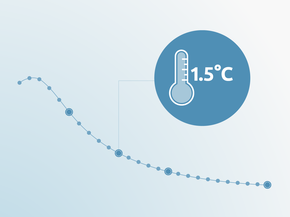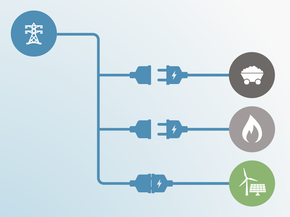Targets
Target Overview
In December 2020, Kenya submitted its updated NDC to the UNFCCC, setting a new target of reducing GHG emissions by 32% by 2030, relative to the business as usual (BAU) scenario of 153 MtCO2e including LULUCF (143 MtCO2e using IPCC SAR values). This target covers all sectors, and is a small improvement from the previous target of a 30% reduction below BAU.
While the previous NDC target was entirely conditional on international support, Kenya now commits to bearing 21% of the mitigation costs, or USD 3.7bn, itself, although the government notes that its financing needs may change with changing circumstances. We calculate this unconditional contribution to be equivalent to an unconditional target of 7% below BAU, including LULUCF – or 4% below BAU, excluding LULUCF emissions. This corresponds to emissions levels of 126 MtCO2e by 2030 (expressed in AR4 values) (see assumptions section).
In its first NDC, Kenya included a separate target of 47% for the LULUCF sector. While the government has dropped explicit reference to this target in the update, we assume Kenya will meet about half of its NDC with reductions in land sector emissions. Excluding this sector, emissions in 2030 will be slightly lower under the new conditional target, decreasing from 110 to 108 MtCO2e. The new conditional target is equivalent to a 17% reduction below BAU by 2030 (excl. LULUCF).
Kenya does not have a net zero target. It is preparing its long-term strategy.
| KENYA — Main climate targets |
|---|
| 2030 unconditional NDC target | |||
|---|---|---|---|
| Formulation of target in NDC | Kenya seeks to abate GHG emissions by 32% by 2030 relative to the BAU scenario of 143 MtCO2e and in line with its sustainable development agenda. Kenya intends to bear 21% of the mitigation cost from domestic sources. | ||
|
Absolute emissions level in 2030 excl. LULUCF |
126 MtCO2e [203% above 1990] [104% above 2010] |
||
| Status | Submitted on 28 December 2020 | ||
| 2030 conditional NDC target | |||
|---|---|---|---|
| Formulation of target in NDC | Kenya seeks to abate GHG emissions by 32% by 2030 relative to the BAU scenario of 143 MtCO2e and in line with its sustainable development agenda. 79% of the mitigation cost is subject to international support. | ||
|
Absolute emissions level in 2030 excl. LULUCF |
108 MtCO2e [159% above 1990] [75% above 2010] |
||
| Status | Submitted on 28 December 2020 | ||
NDC Updates
KENYA:
- Submitted a stronger target on 28 December 2020.
Kenya’s updated NDC has slightly strengthened its 2030 target. Whereas the previous NDC set the target of a 30% emissions reduction below BAU levels by 2030, and was fully dependent on international support, Kenya now commits to reducing BAU emissions by 32% by 2030, intending to meet part of this new target without financial support.
While the introduction of an unconditional target and enhanced NDC is welcome, there is still room for Kenya to further enhance its target. In a bottom-up sectoral analysis completed in 2017, the Ministry of Environment and Natural Resources identified potential emission reductions equivalent to a 60% reduction below BAU by 2030, indicating that Kenya has much greater scope to increase its conditional target. The CAT estimates that this conditional target sits at the top of the country’s emissions trajectory based on current policies and so it is questionable how much real-world action the target will drive.
Kenya’s updated submission does not provide sectoral mitigation targets. Kenya’s new NDC has also dropped its separate LULUCF target, which was a 47% reduction in emissions in the land sector. Most sectoral targets were developed after Kenya submitted its first NDC. We hope that Kenya will adopt a similar approach for the NDC update, and develop and release these targets soon. Other implementation plans have not changed significantly compared to the previous NDC.
The updated NDC provides a non-exhaustive list of priority mitigation measures in various sectors. These include increasing the share of renewables in the national energy grid; enhancement of energy efficiency across sectors; achieving a tree cover of at least 10% of Kenya’s land area; and climate smart agriculture. The NDC also outlines that the planning processes for mitigation activities are determined by the country’s Vision 2030 development programme; the National Climate Change Action Plan; and the National Adaptation Plan.
The NDC update provides much more detail on the country’s planning process, including an overview of Kenya’s policy, legal and institutional framework, as its NDC Revision Process, compared to its first NDC. For a more detailed assessment of Kenya’s Climate Governance, see the CAT’s latest Governance assessment here.
Comparison table
| KENYA — History of NDC updates | First NDC | 2020 NDC update |
|---|---|---|
| 1.5°C compatible |
|
|
| Stronger target | N/A |
|
| Economy-wide coverage |
|
|
| Fixed/absolute target |
|
|
| KENYA | 2016 NDC | 2020 NDC Update |
|---|---|---|
| Formulation of target in NDC |
Unconditional target: N/A Conditional target: 30% below the BAU scenario (incl. LULUCF) by 2030, subject to international support. |
Unconditional target: Kenya will finance at least 21% of required mitigation costs to meet its overall target of 32% below BAU by 2030 (incl. LULUCF). Conditional target: Kenya will rely on international support to finance 79% of the required mitigation costs to meet its overall target of 32% below BAU by 2030 (incl. LULUCF). |
|
Absolute emissions level excl. LULUCF |
Unconditional target: N/A Conditional target: 110 MtCO2e by 2030 |
Unconditional target: 126 MtCO2e by 2030 Conditional target: 108 MtCO2e by 2030 |
|
Emissions compared to 1990 and 2010 excl. LULUCF |
Unconditional target: N/A Conditional target: 164% above 1990 emissions by 2030 78% above 2010 emissions by 2030 |
Unconditional target: 203% above 1990 emissions by 2030 104% above 2010 emissions by 2030 Conditional target: 159% above 1990 emissions by 2030 75% above 2010 emissions by 2030 |
| CAT rating |
Overall rating*: 2°C compatible |
Conditional NDC target against modelled domestic pathways: Critically Insufficient Unconditional NDC target against fair share: 1.5°C compatible |
| Sector coverage | Economy-wide | Economy-wide |
| Separate target for LULUCF |
Yes LULUCF sector to deliver 47% of the mitigation target |
No (Assume unchanged in calculations) |
| Gas coverage | CO2, CH4, N2O are prioritised | CO2, CH4, N2O are prioritised. The updated NDC may cover PFCs, HFCs, SF6 and NF3– gases which are currently negligible |
| Target type | Emissions reduction from BAU | Emissions reduction from BAU |
| Explanation why the target is a fair contribution towards the global goal | Provided, Kenya argues it has a low historical responsibility and limited capabilities | Provided, Kenya states it is a developing country with diverse economic development challenges and contributes less than 0.1% to total global emissions |
* Before September 2021, all CAT ratings were based exclusively on fair share and only assessed a country’s target.
Target development timeline & previous CAT analysis
[NOTE: all assumptions made directly in the Assumptions tab under “NDC”]
CAT rating of targets
NDC description
The CAT rates NDC targets against what a fair contribution to achieving the Paris Agreement’s long-term temperature goal would be as well as against what needs to happen within a country’s own borders. Kenya will need international support to achieve those needed reductions within its borders.
Kenya’s NDC target outlines the mitigation costs that will be financed using its own resources versus those requiring international support. We rate the country’s unconditional target against its fair share contribution (‘Unconditional NDC target against fair share’) and its conditional target against the level of reductions needed within its border (‘Conditional NDC target against modelled domestic pathways’).
The CAT rates Kenya’s conditional NDC target against modelled domestic pathways as “Critically insufficient” and its NDC target against fair share as “1.5°C compatible”. The strong difference in the two ratings reflects Kenya’s situation as a country with strong development needs and a small historical responsibility, but with relevant mitigation potential on its own territory, which it should exploit to a large extent with the help of international support.
We rate Kenya’s conditional NDC as “Critically insufficient” when compared to modelled domestic pathways. The “Critically insufficient” rating indicates that it reflects minimal to no action and is not at all consistent with the 1.5°C temperature limit. If all countries were to follow Kenya’s approach, warming would exceed 4°C. Kenya should improve its conditional target and specify support needs to achieve it. Even a small improvement in the target would change the rating to “Highly insufficient”.
We rate Kenya’s 2030 unconditional NDC target as “1.5°C compatible” when compared with its fair-share contribution to climate action. The “1.5°C compatible” rating indicates that Kenya’s unconditional NDC target is consistent with limiting warming to 1.5°C. Kenya’s NDC target does not require other countries to make comparably deeper reductions or greater effort and is in the most stringent part of its Fair Share range.
Further information on how the CAT rates countries (against modelled pathways and fair share) can be found here.
Net zero and other long-term target(s)
We evaluate the net zero target as: No net zero target.
Further analysis
Latest publications
Stay informed
Subscribe to our newsletter







